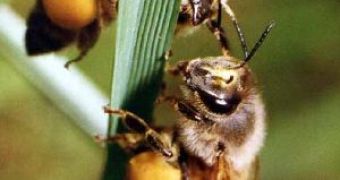Most plants need to be pollinated in order to produce seeds and fruits.
The majority of cultivated plant species, with few exceptions ( e.g. cereals and hemp ), need insects to accomplish it.
Domesticated honeybees pollinate plants which provide up to a third of our food supply.
Honeybees are good pollinators because of their number and cooperative colonies. In their quest for nectar and pollen, they carry pollen from flower to flower.
Some crops like pumpkins and watermelons depend almost entirely on honeybees.
U.S. honeybee numbers are decreasing due to an invasive alien mite that feeds on the bees and their larvae.
"We don't have the huge numbers of them that we used to," said Sarah Greenleaf, a postdoctoral researcher at UC Davis
"There have been years where there weren't enough honeybees to rent to pollinate some crops."
In a new study, she revealed that the insects are up to five times more efficient when wild bees occur in the same fields.
"As honeybees become more scarce, it becomes more important to have better pollinators," said Greenleaf.
She studied for two years honeybees' pollinating efficiency in sunflower crops on farms in Yolo County, California, near UC Davis.
Wild bees are much less efficient than honeybees to crop pollination.
But where wild bees were abundant, honeybees were much more effective in pollinating.
There may be two reasons for this.
Male wild bees will harass worker honeybees, which are sterile females, scaring them off a neighboring flower, making them pass through more flowers than they normally would.
Secondly, female wild bees appear to drive away honeybees in the competition for protein-providing pollen.
"If there's another bee on a flower that you want to be on, it makes sense to try to knock that bee off," she said.
Frequent movement between flowers spreads pollen around more effectively.
Greenleaf and Claire Kremen, professor at UC Berkeley, calculated a gain produced by this finding of about $10 to $26-million to the sunflower industry alone.
The researchers said that farmers could benefit by establishing their fields next to natural habitats, with more wild bees, or by planting hedgerows that attract wild bees.
"If farmers were to do that, I think it could really increase their yield," Greenleaf said.

 14 DAY TRIAL //
14 DAY TRIAL //